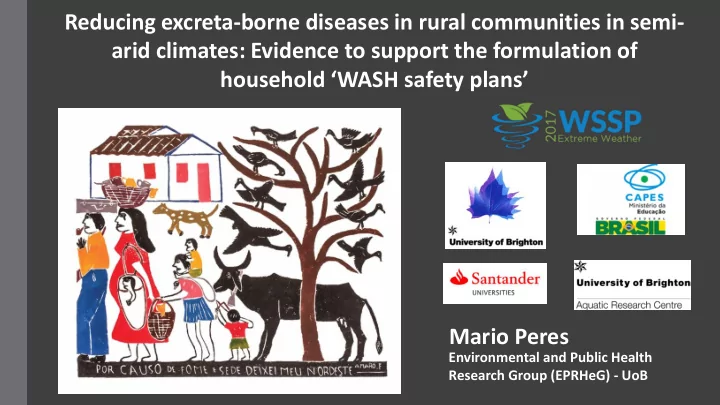

Reducing excreta-borne diseases in rural communities in semi- arid climates: Evidence to support the formulation of household ‘WASH safety plans’ Mario Peres Environmental and Public Health Research Group (EPRHeG) - UoB
Introduction Brazilian semi-arid Source: ANA/MI.
Progression of diarrhoeal diseases in the past 11 years 600 Number of acute diarrhoeal cases 500 400 300 200 Nova Palmeira 100 Picuí 0 2006 2007 2008 2009 2010 2011 2012 2013 2014 2015 2016 Year
Methodology Tiered approach • 99 households • 312 samples of water • Physico-chemical analysis • Microbiological analysis • Culture • Real-time PCR • QMRA
Household and Sanitary Survey • 87% - two or three water sources • 79% - at least two water storage systems • Buckets (89%) vs. hand pumps (14%) • HRW, TW and DW for drinking • POU treatment (50%) • 89% - pour-flush toilet - soakaways • Sanitary inspection
Water Supply System in Rural Communities
Microbial Transmission Routes at the Household Level
Monitoring Outcomes 4 4 E. coli (Log10 CFU/100 mL) 3 3 IE (Log10 CFU/100 mL) 2 2 1 1 0 Chlorine Ceramic filter None 0 Drinking water treatment Chlorine Ceramic filter None Drinking water treatment • Reported chlorine use vs. level of free chlorine
Monitoring Outcomes • Low detection of somatic coliphages (19% - SS and 20% - DWSC) Tankered water (Army operation) Desalinated water 4 3.5 3.0 3 • E. coli vs. IE 2.5 Log10 (CFU/100 mL) Log10 (CFU/100 mL) 2.0 2 1.5 • Increase level of 1.0 1 FIO in the SS? 0.5 0.0 0 DWSC DWSC SS WS WS DWSC DWSC SS WS WS E. coli E. coli Intestinal enterococci Intestinal enterococci
Development of QMRA
Takeaway Points • Alternative water sources vs. water quality • ’Safe’ water supply vs. consumption of ‘safe’ water • Lack of adequate health and safety training + Hygiene + Sanitation Water safety plan ‘WASH safety plan’
“The semi-arid environment is perfectly habitable when individuals desire to make it so and the political will is there to support it” (ASA,1999) Thank you! Mario Rodrigues Peres EPHReG - University of Brighton m.peres@brighton.ac.uk Tel.: +44 1273 643455
Recommend
More recommend